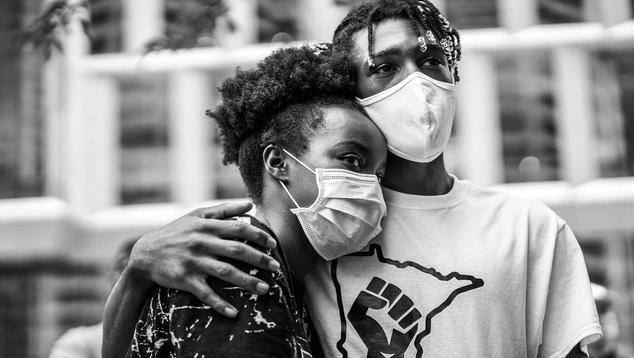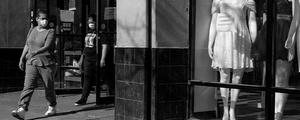Story Highlights
- Reports of feeling anger rose from 25% to 38%, then fell back to 27%
- Fewer Americans reported enjoyment or happiness in early June
- Surge-and-decline pattern in negative emotions seen among all party groups
WASHINGTON, D.C. -- In the first week of June, more Americans reported experiencing negative emotions -- and fewer reported experiencing positive emotions -- than in the week prior. By the second week of June, the percentages reporting those same emotions returned to their former levels.

Line graph. Between late May and early June, Americans were more likely to report feeling anger, sadness, worry and stress, and less likely to report feeling enjoyment and happiness. But in the second week of June, those emotions reverted back to the levels they were at in late May.
Reports of feeling anger changed more than any emotion, rising from 25% in the last week of May to 38% in the first week of June, before falling back to 27% the following week. There was a nearly double-digit increase in the percentage of Americans feeling sadness, with smaller increases for worry and stress.
Slightly fewer Americans said they felt happiness and enjoyment -- the two positive emotions Gallup is tracking -- during the first week of June than in the prior week. But like the negative emotions, the proportions of Americans feeling happiness and enjoyment are back to where they had been.
The first week of June was an eventful one in the U.S., as millions of Americans protested racial injustice in the U.S. after the May 25 death of George Floyd, a black man from Minneapolis, who was killed while in police custody. Those protests were largely peaceful, but some did result in looting or destruction of property. The Trump administration's response to the protests was widely criticized.
These results are part of Gallup's ongoing COVID-19 tracking survey and based on interviews with weekly random samples of Gallup's probability-based panel.
Americans remain less likely to say they are experiencing worry and stress, and more likely to say they have felt happiness and enjoyment, than in late March and early April, when most Americans were living under stay-at-home orders to slow the spread of the coronavirus. U.S. adults are about as likely now as they were earlier in the COVID-19 crisis to say they feel anger and sadness.
Surge-and-Decline Pattern Seen Among All Key Subgroups
During the week of June 1-7, members of key subgroups, including by party identification, age, race and education, tended to show increased negative emotions and decreased positive emotions, with those effects subsiding partially or completely the week of June 8-14.
For example, there were double-digit increases in the percentage of Democrats, independents and Republicans who reported feeling anger between late May and early June. Democrats (43%) were the most likely of those groups to say they were angry, followed by independents (37%) and Republicans (32%).
In the second week of June, all party groups showed declines in reports of anger, although Republicans were still more likely to report feeling anger (28%) than they were during the last week of May. Democrats and independents were back to the prior levels.
This general pattern among the party groups was also seen in other emotions measured. One notable exception is that Republicans' reports of positive emotions were steady across the three weeks.
| May 25-31 | June 1-7 | June 8-14 | ||||||||||||||||||||||||||||||||||||||||||||||||||||||||||||||||||||||||||||||||||||||||||||||||||
|---|---|---|---|---|---|---|---|---|---|---|---|---|---|---|---|---|---|---|---|---|---|---|---|---|---|---|---|---|---|---|---|---|---|---|---|---|---|---|---|---|---|---|---|---|---|---|---|---|---|---|---|---|---|---|---|---|---|---|---|---|---|---|---|---|---|---|---|---|---|---|---|---|---|---|---|---|---|---|---|---|---|---|---|---|---|---|---|---|---|---|---|---|---|---|---|---|---|---|---|---|
| % | % | % | ||||||||||||||||||||||||||||||||||||||||||||||||||||||||||||||||||||||||||||||||||||||||||||||||||
| Democrats | ||||||||||||||||||||||||||||||||||||||||||||||||||||||||||||||||||||||||||||||||||||||||||||||||||||
| Anger | 29 | 43 | 29 | |||||||||||||||||||||||||||||||||||||||||||||||||||||||||||||||||||||||||||||||||||||||||||||||||
| Sadness | 39 | 49 | 37 | |||||||||||||||||||||||||||||||||||||||||||||||||||||||||||||||||||||||||||||||||||||||||||||||||
| Worry | 57 | 60 | 55 | |||||||||||||||||||||||||||||||||||||||||||||||||||||||||||||||||||||||||||||||||||||||||||||||||
| Stress | 56 | 63 | 56 | |||||||||||||||||||||||||||||||||||||||||||||||||||||||||||||||||||||||||||||||||||||||||||||||||
| Enjoyment | 63 | 58 | 63 | |||||||||||||||||||||||||||||||||||||||||||||||||||||||||||||||||||||||||||||||||||||||||||||||||
| Happiness | 67 | 62 | 65 | |||||||||||||||||||||||||||||||||||||||||||||||||||||||||||||||||||||||||||||||||||||||||||||||||
| Independents | ||||||||||||||||||||||||||||||||||||||||||||||||||||||||||||||||||||||||||||||||||||||||||||||||||||
| Anger | 26 | 37 | 23 | |||||||||||||||||||||||||||||||||||||||||||||||||||||||||||||||||||||||||||||||||||||||||||||||||
| Sadness | 25 | 35 | 26 | |||||||||||||||||||||||||||||||||||||||||||||||||||||||||||||||||||||||||||||||||||||||||||||||||
| Worry | 44 | 49 | 42 | |||||||||||||||||||||||||||||||||||||||||||||||||||||||||||||||||||||||||||||||||||||||||||||||||
| Stress | 56 | 55 | 51 | |||||||||||||||||||||||||||||||||||||||||||||||||||||||||||||||||||||||||||||||||||||||||||||||||
| Enjoyment | 71 | 61 | 74 | |||||||||||||||||||||||||||||||||||||||||||||||||||||||||||||||||||||||||||||||||||||||||||||||||
| Happiness | 71 | 69 | 75 | |||||||||||||||||||||||||||||||||||||||||||||||||||||||||||||||||||||||||||||||||||||||||||||||||
| Republicans | ||||||||||||||||||||||||||||||||||||||||||||||||||||||||||||||||||||||||||||||||||||||||||||||||||||
| Anger | 20 | 32 | 28 | |||||||||||||||||||||||||||||||||||||||||||||||||||||||||||||||||||||||||||||||||||||||||||||||||
| Sadness | 20 | 26 | 24 | |||||||||||||||||||||||||||||||||||||||||||||||||||||||||||||||||||||||||||||||||||||||||||||||||
| Worry | 34 | 39 | 38 | |||||||||||||||||||||||||||||||||||||||||||||||||||||||||||||||||||||||||||||||||||||||||||||||||
| Stress | 42 | 44 | 42 | |||||||||||||||||||||||||||||||||||||||||||||||||||||||||||||||||||||||||||||||||||||||||||||||||
| Enjoyment | 76 | 74 | 75 | |||||||||||||||||||||||||||||||||||||||||||||||||||||||||||||||||||||||||||||||||||||||||||||||||
| Happiness | 80 | 79 | 80 | |||||||||||||||||||||||||||||||||||||||||||||||||||||||||||||||||||||||||||||||||||||||||||||||||
| Gallup Panel, 2020 | ||||||||||||||||||||||||||||||||||||||||||||||||||||||||||||||||||||||||||||||||||||||||||||||||||||
White people and nonwhite people showed similar increases on most of the emotions, including anger. Nonwhite people had a slightly greater increase in reports of sadness than white people. Both groups' percentages are largely back to where they were in late May, but nonwhite people's reports of positive emotions stayed lower in the second week of June.
| May 25-31 | June 1-7 | June 8-14 | ||||||||||||||||||||||||||||||||||||||||||||||||||||||||||||||||||||||||||||||||||||||||||||||||||
|---|---|---|---|---|---|---|---|---|---|---|---|---|---|---|---|---|---|---|---|---|---|---|---|---|---|---|---|---|---|---|---|---|---|---|---|---|---|---|---|---|---|---|---|---|---|---|---|---|---|---|---|---|---|---|---|---|---|---|---|---|---|---|---|---|---|---|---|---|---|---|---|---|---|---|---|---|---|---|---|---|---|---|---|---|---|---|---|---|---|---|---|---|---|---|---|---|---|---|---|---|
| % | % | % | ||||||||||||||||||||||||||||||||||||||||||||||||||||||||||||||||||||||||||||||||||||||||||||||||||
| Non-Hispanic White | ||||||||||||||||||||||||||||||||||||||||||||||||||||||||||||||||||||||||||||||||||||||||||||||||||||
| Anger | 24 | 37 | 28 | |||||||||||||||||||||||||||||||||||||||||||||||||||||||||||||||||||||||||||||||||||||||||||||||||
| Sadness | 27 | 35 | 29 | |||||||||||||||||||||||||||||||||||||||||||||||||||||||||||||||||||||||||||||||||||||||||||||||||
| Worry | 46 | 50 | 46 | |||||||||||||||||||||||||||||||||||||||||||||||||||||||||||||||||||||||||||||||||||||||||||||||||
| Stress | 51 | 55 | 50 | |||||||||||||||||||||||||||||||||||||||||||||||||||||||||||||||||||||||||||||||||||||||||||||||||
| Enjoyment | 69 | 64 | 72 | |||||||||||||||||||||||||||||||||||||||||||||||||||||||||||||||||||||||||||||||||||||||||||||||||
| Happiness | 74 | 71 | 76 | |||||||||||||||||||||||||||||||||||||||||||||||||||||||||||||||||||||||||||||||||||||||||||||||||
| Nonwhite | ||||||||||||||||||||||||||||||||||||||||||||||||||||||||||||||||||||||||||||||||||||||||||||||||||||
| Anger | 29 | 43 | 26 | |||||||||||||||||||||||||||||||||||||||||||||||||||||||||||||||||||||||||||||||||||||||||||||||||
| Sadness | 34 | 46 | 33 | |||||||||||||||||||||||||||||||||||||||||||||||||||||||||||||||||||||||||||||||||||||||||||||||||
| Worry | 48 | 52 | 48 | |||||||||||||||||||||||||||||||||||||||||||||||||||||||||||||||||||||||||||||||||||||||||||||||||
| Stress | 52 | 55 | 51 | |||||||||||||||||||||||||||||||||||||||||||||||||||||||||||||||||||||||||||||||||||||||||||||||||
| Enjoyment | 69 | 62 | 64 | |||||||||||||||||||||||||||||||||||||||||||||||||||||||||||||||||||||||||||||||||||||||||||||||||
| Happiness | 67 | 65 | 64 | |||||||||||||||||||||||||||||||||||||||||||||||||||||||||||||||||||||||||||||||||||||||||||||||||
| Gallup Panel, 2020 | ||||||||||||||||||||||||||||||||||||||||||||||||||||||||||||||||||||||||||||||||||||||||||||||||||||
Bottom Line
Nearly a month after Floyd's death, Americans continue to protest racial injustice. Congress and the president have taken some initial steps to address police actions that have been factors in the recent deaths of black people. The incidents have certainly raised awareness of and sensitivity to matters of race.
The effect of the events of late May and early June on Americans have been borne out in public opinion surveys, including a sharp drop in President Donald Trump's job approval rating and satisfaction with the country more generally. And Americans were more inclined to experience strong negative emotions during that period, though those effects seem to have been short-lived.
The sharp increase in anger and sadness during the first week in June contrasts with similar increases in stress and worry in March, during the early days of the COVID-19 outbreak and associated social isolation policies. These results illustrate the different circumstances under which negative emotions are experienced on a daily basis.
Learn more about how the Gallup Panel works.




